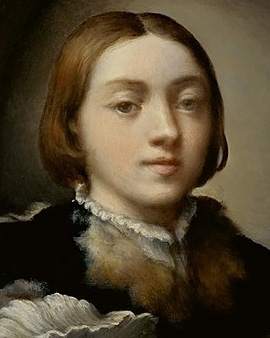The real name of Parmigianino is Girolimo Francesco Maria Mazzola. He was the eighth son of Filippo Mazola from the city of Parma and comes from a widely spread family of craftsmen and artists. His father died early of the plague, several uncles raised the boy and promoted his numerous talents in natural sciences, music and art. At the age of 18, the young Parmigianino went to the city of Viadana and got work decorating the church of San Giovanni. Legend has it that he met the famous Italian Renaissance painter Antonio da Correggio there on the scaffolding in the dome, who became his great role model. Parmigianino himself painted the arch reveals of three side chapels in the church. Later, despite his great youth, the artist was commissioned to paint in the Cathedral of Parma, a work which again earned him great recognition.
In 1524 the artist travelled to Rome, where he was celebrated at court as the "new Raphael", whom he emulated. An example of this is his famous work "Self-Portrait in a Convex Mirror". Pope Clement VII even promised him a commission, the decoration of a Sales in the Vatican Church. Parmigianino continued to study and paint. Well-known works from this period are " Portrait of Lorenzo Cibo", "Madonna with Child" and Madonna with John the Baptist and St. Jerome". After his stay in Rome, Parmigianino lived in Bologna for several years and worked closely with the engraver Antonio da Trento. Later the two artists split up. As a result, Parmigianino lost all the drawings and engravings he had made during this period. When the artist left Bologna, he returned to his native Parma, where he undertook to design the barrel vault and the apse of the newly built church of Santa Maria della Steccata. Parmigianino completed the barrel vaulting, but his physical strength failed him at the apse. This was later completed by the famous fresco painter Michelangelo Anselmi. Parmigianino retired and died in 1540 at the age of only 37 years of river fever (probably malaria).
Despite his short life, the artist left many important works, which can be seen today in famous museums, such as the Hermitage in St. Petersburg or the Louvre in Paris.
×





.jpg)
.jpg)
_-_Antea_Representation_of_Sthenebee_wife_of_King_Proetos_she_falls_in_love_with_Be_-_(MeisterDrucke-1021852).jpg)
_-_Antea_Representation_of_Sthenebee_wife_of_King_Proetos_she_falls_in_love_with_Be_-_(MeisterDrucke-1021852).jpg)
.jpg)
.jpg)
.jpg)
.jpg)
.jpg)
.jpg)
.jpg)
.jpg)
.jpg)
.jpg)
_-_Madonna_dal_collo_lungo_(Madonna_with_long_neck)_painting_by_Girolamo_Fra_Mazzol_-_(MeisterDrucke-945706).jpg)
_-_Madonna_dal_collo_lungo_(Madonna_with_long_neck)_painting_by_Girolamo_Fra_Mazzol_-_(MeisterDrucke-945706).jpg)
_-_Actaeons_transformation_into_stag_from_Myth_of_Diana_and_Actaeon_circa_1524_by_F_-_(MeisterDrucke-1110149).jpg)
_-_Actaeons_transformation_into_stag_from_Myth_of_Diana_and_Actaeon_circa_1524_by_F_-_(MeisterDrucke-1110149).jpg)
 Receiving the World c1529 - (MeisterDrucke-165668).jpg)
 Receiving the World c1529 - (MeisterDrucke-165668).jpg)
.jpg)
.jpg)
_-_Two_nude_men_lifting_a_sick_man_from_a_tired_horse_(pen_brown_ink_with_brown_wa_-_(MeisterDrucke-1090419).jpg)
_-_Two_nude_men_lifting_a_sick_man_from_a_tired_horse_(pen_brown_ink_with_brown_wa_-_(MeisterDrucke-1090419).jpg)
.jpg)
.jpg)
 c1528-30 - (MeisterDrucke-129454).jpg)
 c1528-30 - (MeisterDrucke-129454).jpg)
.jpg)
.jpg)
_-_Actaeon_turned_into_a_stag_is_eaten_by_his_own_dogs_from_the_Room_of_Diana_and_A_-_(MeisterDrucke-1399583).jpg)
_-_Actaeon_turned_into_a_stag_is_eaten_by_his_own_dogs_from_the_Room_of_Diana_and_A_-_(MeisterDrucke-1399583).jpg)
 (chiaroscuro woodcut) - (MeisterDrucke-111039).jpg)
 (chiaroscuro woodcut) - (MeisterDrucke-111039).jpg)
_-_Madonna_and_Child_Saint_Margarita_Saint_Michael_Saint_Jerome_and_Saint_Petronio_-_(MeisterDrucke-961135).jpg)
_-_Madonna_and_Child_Saint_Margarita_Saint_Michael_Saint_Jerome_and_Saint_Petronio_-_(MeisterDrucke-961135).jpg)
.jpg)
.jpg)
_-_Portrait_of_Man_Man_Painting_by_Francesco_Mazzola_Il_Parmigianino_dit_The_Parmes_-_(MeisterDrucke-946722).jpg)
_-_Portrait_of_Man_Man_Painting_by_Francesco_Mazzola_Il_Parmigianino_dit_The_Parmes_-_(MeisterDrucke-946722).jpg)
.jpg)
.jpg)
 1 - (MeisterDrucke-568004).jpg)
 1 - (MeisterDrucke-568004).jpg)
.jpg)
.jpg)
_-_Jonge_en_een_oude_geitenhoeder_-_(MeisterDrucke-1384582).jpg)
_-_Jonge_en_een_oude_geitenhoeder_-_(MeisterDrucke-1384582).jpg)
_-_Diana_turning_Actaeon_into_stag_detail_from_Myth_of_Diana_and_Actaeon_circa_1524_-_(MeisterDrucke-1110155).jpg)
_-_Diana_turning_Actaeon_into_stag_detail_from_Myth_of_Diana_and_Actaeon_circa_1524_-_(MeisterDrucke-1110155).jpg)
_-_Putto_from_Myth_of_Diana_and_Actaeon_-_(MeisterDrucke-1103581).jpg)
_-_Putto_from_Myth_of_Diana_and_Actaeon_-_(MeisterDrucke-1103581).jpg)
.jpg)
.jpg)
_-_Actaeon_turned_into_stag_by_Diana_detail_of_the_Diane_and_Acteon_hall_-_(MeisterDrucke-1082277).jpg)
_-_Actaeon_turned_into_stag_by_Diana_detail_of_the_Diane_and_Acteon_hall_-_(MeisterDrucke-1082277).jpg)
_(engraving)_-_(MeisterDrucke-35350).jpg)
_(engraving)_-_(MeisterDrucke-35350).jpg)
.jpg)
.jpg)
_-_(MeisterDrucke-72566).jpg)
_-_(MeisterDrucke-72566).jpg)
_-_Minerva_-_(MeisterDrucke-1357040).jpg)
_-_Minerva_-_(MeisterDrucke-1357040).jpg)
_-_The_favorite_or_Turkish_slave_Painting_by_Francesco_Mazzola_Il_Parmigianino_call_-_(MeisterDrucke-988278).jpg)
_-_The_favorite_or_Turkish_slave_Painting_by_Francesco_Mazzola_Il_Parmigianino_call_-_(MeisterDrucke-988278).jpg)
_-_Pair_of_nymphs_from_Myth_of_Diana_and_Actaeon_-_(MeisterDrucke-1110048).jpg)
_-_Pair_of_nymphs_from_Myth_of_Diana_and_Actaeon_-_(MeisterDrucke-1110048).jpg)
.jpg)
.jpg)
 - (MeisterDrucke-44991).jpg)
 - (MeisterDrucke-44991).jpg)
.jpg)
.jpg)
.jpg)
.jpg)
_-_Diogenes_-_(MeisterDrucke-1361546).jpg)
_-_Diogenes_-_(MeisterDrucke-1361546).jpg)
_-_Portrait_of_Lorenzo_Cybo_-_(MeisterDrucke-908583).jpg)
_-_Portrait_of_Lorenzo_Cybo_-_(MeisterDrucke-908583).jpg)
.jpg)
.jpg)
_-_Actaeon_with_feminine_features_from_Myth_of_Diana_and_Actaeon_circa_-_(MeisterDrucke-1123797).jpg)
_-_Actaeon_with_feminine_features_from_Myth_of_Diana_and_Actaeon_circa_-_(MeisterDrucke-1123797).jpg)
_-_Aanbidding_door_de_koningen_-_(MeisterDrucke-1370698).jpg)
_-_Aanbidding_door_de_koningen_-_(MeisterDrucke-1370698).jpg)
_-_Vrouwelijke_heilige_ontvangt_het_Christuskind_-_(MeisterDrucke-1374621).jpg)
_-_Vrouwelijke_heilige_ontvangt_het_Christuskind_-_(MeisterDrucke-1374621).jpg)
_-_Cherub_and_Dianas_face_from_Myth_of_Diana_and_Actaeon_circa_-_(MeisterDrucke-1109873).jpg)
_-_Cherub_and_Dianas_face_from_Myth_of_Diana_and_Actaeon_circa_-_(MeisterDrucke-1109873).jpg)
_-_Self-portrait_by_Francesco_Parmigianino_(1503-1540)_-_(MeisterDrucke-1120163).jpg)
_-_Self-portrait_by_Francesco_Parmigianino_(1503-1540)_-_(MeisterDrucke-1120163).jpg)
_-_Saint_Agatha_by_Parmigianino_(1503-1540)_fresco_Church_of_San_Giovanni_Evangelis_-_(MeisterDrucke-1081202).jpg)
_-_Saint_Agatha_by_Parmigianino_(1503-1540)_fresco_Church_of_San_Giovanni_Evangelis_-_(MeisterDrucke-1081202).jpg)
_-_Study_of_a_mans_right_arm_his_hand_holding_a_stick_(red_chalk_on_white_paper)_-_(MeisterDrucke-1090304).jpg)
_-_Study_of_a_mans_right_arm_his_hand_holding_a_stick_(red_chalk_on_white_paper)_-_(MeisterDrucke-1090304).jpg)
_-_Badende_nimfen_-_(MeisterDrucke-1374911).jpg)
_-_Badende_nimfen_-_(MeisterDrucke-1374911).jpg)
.jpg)
.jpg)
_-_Virgin_with_long_neck_-_1534_Oil_on_wood_-_(MeisterDrucke-972427).jpg)
_-_Virgin_with_long_neck_-_1534_Oil_on_wood_-_(MeisterDrucke-972427).jpg)
_-_Half-length_of_a_seated_woman_(pen_ink_on_paper)_-_(MeisterDrucke-1087890).jpg)
_-_Half-length_of_a_seated_woman_(pen_ink_on_paper)_-_(MeisterDrucke-1087890).jpg)
.jpg)
.jpg)
_-_Heilige_Cecilia_musicerend_-_(MeisterDrucke-1374790).jpg)
_-_Heilige_Cecilia_musicerend_-_(MeisterDrucke-1374790).jpg)
_-_Diogenes_-_(MeisterDrucke-1360594).jpg)
_-_Diogenes_-_(MeisterDrucke-1360594).jpg)
_-_Three_wise_virgins_detail_of_Three_wise_virgins_and_three_foolish_virgins_by_Fra_-_(MeisterDrucke-1081283).jpg)
_-_Three_wise_virgins_detail_of_Three_wise_virgins_and_three_foolish_virgins_by_Fra_-_(MeisterDrucke-1081283).jpg)
_-_Wedstrijd_tussen_Apollo_en_Marsyas_-_(MeisterDrucke-1406381).jpg)
_-_Wedstrijd_tussen_Apollo_en_Marsyas_-_(MeisterDrucke-1406381).jpg)
_-_Back_view_of_a_woman_carrying_a_child_a_man_leaning_on_his_staff_waits_in_a_door_-_(MeisterDrucke-1080118).jpg)
_-_Back_view_of_a_woman_carrying_a_child_a_man_leaning_on_his_staff_waits_in_a_door_-_(MeisterDrucke-1080118).jpg)
.jpg)
.jpg)
_-_Knielende_DavidLibreto_di_diversi_figurine_dissignato_da_Fran_parmensis_et_conse_-_(MeisterDrucke-1362918).jpg)
_-_Knielende_DavidLibreto_di_diversi_figurine_dissignato_da_Fran_parmensis_et_conse_-_(MeisterDrucke-1362918).jpg)
_-_Room_of_Diana_and_Actaeon_detail_of_2384753_-_(MeisterDrucke-1406598).jpg)
_-_Room_of_Diana_and_Actaeon_detail_of_2384753_-_(MeisterDrucke-1406598).jpg)
.jpg)
.jpg)
_-_Heilige_FilippusChristus_en_de_twaalf_apostelen_(series_title)_-_(MeisterDrucke-1374591).jpg)
_-_Heilige_FilippusChristus_en_de_twaalf_apostelen_(series_title)_-_(MeisterDrucke-1374591).jpg)
.jpg)
.jpg)
.jpg)
.jpg)
_-_Heilige_AndreasChristus_en_de_twaalf_apostelen_(series_title)_-_(MeisterDrucke-1405326).jpg)
_-_Heilige_AndreasChristus_en_de_twaalf_apostelen_(series_title)_-_(MeisterDrucke-1405326).jpg)
_-_Hoop_-_(MeisterDrucke-1370241).jpg)
_-_Hoop_-_(MeisterDrucke-1370241).jpg)
_-_Odysseus_op_het_eiland_van_Circe_-_(MeisterDrucke-1368009).jpg)
_-_Odysseus_op_het_eiland_van_Circe_-_(MeisterDrucke-1368009).jpg)
_-_The_Nymph_seized_by_the_pastor_by_Francesco_Mazzola_known_as_Parmigianino_(1503-_-_(MeisterDrucke-1104172).jpg)
_-_The_Nymph_seized_by_the_pastor_by_Francesco_Mazzola_known_as_Parmigianino_(1503-_-_(MeisterDrucke-1104172).jpg)
.jpg)
.jpg)
_-_Heilige_MatteuesChristus_en_de_twaalf_apostelen_(series_title)_-_(MeisterDrucke-1374791).jpg)
_-_Heilige_MatteuesChristus_en_de_twaalf_apostelen_(series_title)_-_(MeisterDrucke-1374791).jpg)
.jpg)
.jpg)
.jpg)
.jpg)
_-_Heilige_Cecilia_musicerend_-_(MeisterDrucke-1374972).jpg)
_-_Heilige_Cecilia_musicerend_-_(MeisterDrucke-1374972).jpg)
_-_Putto_from_Myth_of_Diana_and_Actaeon_-_(MeisterDrucke-1120055).jpg)
_-_Putto_from_Myth_of_Diana_and_Actaeon_-_(MeisterDrucke-1120055).jpg)
.jpg)
.jpg)
.jpg)
.jpg)
.jpg)
.jpg)
.jpg)
.jpg)
_-_Diana_dipping_into_spring_from_Myth_of_Diana_and_Actaeon_-_(MeisterDrucke-1109914).jpg)
_-_Diana_dipping_into_spring_from_Myth_of_Diana_and_Actaeon_-_(MeisterDrucke-1109914).jpg)
.jpg)
.jpg)
.jpg)
.jpg)
.jpg)
.jpg)
_-_Figure_of_hunter_from_Myth_of_Diana_and_Actaeon_-_(MeisterDrucke-1110044).jpg)
_-_Figure_of_hunter_from_Myth_of_Diana_and_Actaeon_-_(MeisterDrucke-1110044).jpg)
.jpg)
.jpg)
.jpg)
.jpg)
.jpg)
.jpg)
 - (MeisterDrucke-165857).jpg)
 - (MeisterDrucke-165857).jpg)
_-_Diana_op_jacht_-_(MeisterDrucke-1374415).jpg)
_-_Diana_op_jacht_-_(MeisterDrucke-1374415).jpg)
.jpg)
.jpg)
.jpg)
.jpg)
.jpg)
.jpg)
.jpg)
.jpg)
_-_Study_of_Virgin_for_church_of_Detached_by_Francesco_Parmigianino_(1503-1540)_-_(MeisterDrucke-1123327).jpg)
_-_Study_of_Virgin_for_church_of_Detached_by_Francesco_Parmigianino_(1503-1540)_-_(MeisterDrucke-1123327).jpg)
_-_Actaeon_with_his_companions_detail_from_Myth_of_Diana_and_Actaeon_circa_1524_by_-_(MeisterDrucke-1109874).jpg)
_-_Actaeon_with_his_companions_detail_from_Myth_of_Diana_and_Actaeon_circa_1524_by_-_(MeisterDrucke-1109874).jpg)
.jpg)
.jpg)
_-_A_satyress_asleep_under_a_tree_(black_chalk_with_heightening_in_white_body_colou_-_(MeisterDrucke-1093755).jpg)
_-_A_satyress_asleep_under_a_tree_(black_chalk_with_heightening_in_white_body_colou_-_(MeisterDrucke-1093755).jpg)
_-_Three_Foolish_Virgins_by_Francesco_Mazzola_known_as_Parmigianino_-_(MeisterDrucke-1110064).jpg)
_-_Three_Foolish_Virgins_by_Francesco_Mazzola_known_as_Parmigianino_-_(MeisterDrucke-1110064).jpg)
.jpg)
.jpg)
.jpg)
.jpg)






